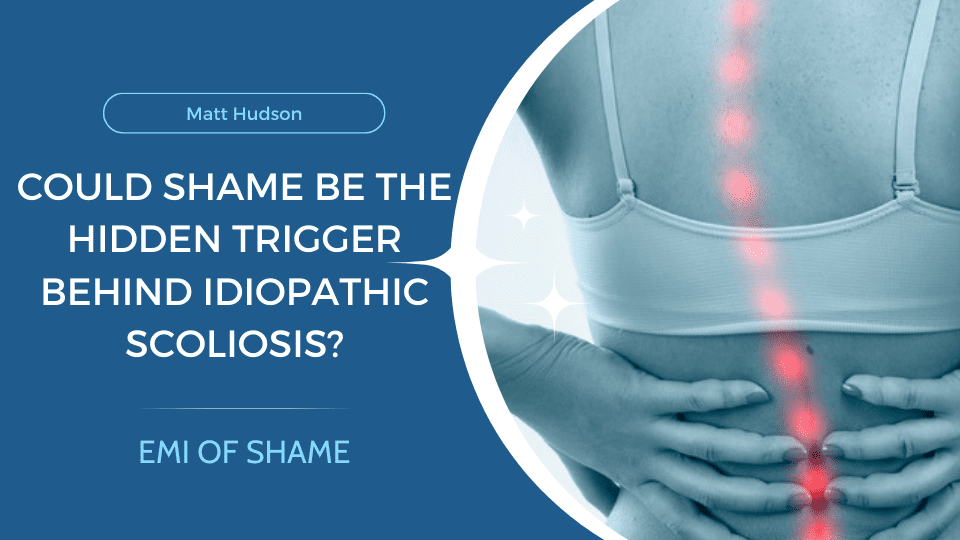Idiopathic scoliosis, a condition in which the spine curves sideways without a known cause, affects millions of people around the world[i]. In under 10 years the prevalence, which is higher in girls than boys, has increased from 0.47-5.2%[ii] up to 0.93-12% globally[iii]. While its exact aetiology remains uncertain, researchers have considered various potential triggers and factors, ranging from genetic predispositions to environmental contributors. An emerging and intriguing hypothesis is the potential connection between emotional states, particularly shame, and the development or exacerbation of idiopathic scoliosis. This article explores this hypothesis, reviewing the existing evidence and theoretical implications.
The Body-Mind Connection
The link between emotional health and physical manifestations has long been acknowledged in various disciplines, from traditional Eastern medical practices to modern psychosomatic medicine. Emotions like anxiety, depression, and stress have been shown to affect our physical health, sometimes in profound ways[iv].
Shame, a deeply ingrained emotion associated with feelings of unworthiness or perceived defects, might impact our bodies in ways we are just beginning to understand. Physiologically, shame can trigger the “fight or flight” response, releasing cortisol, increasing heart rate, and causing other bodily reactions. Over time, chronic shame could lead to chronic physiological changes[v].
The Posture of Shame
When we think of someone feeling ashamed, we often picture a particular posture: hunched shoulders, downcast eyes, and a bowed head. Over time, could these postural adaptations, if persistent and combined with other factors, contribute to the development of a physical curve in the spine?
The thought is not entirely unfounded. Chronic postural changes can lead to structural changes in the body. For instance, people who consistently look down at their phones or computers can develop a “tech neck” or forward head posture[vi].
Current Research and Findings
While the concept of emotional states leading to physical manifestations is widely accepted, the direct link between shame and scoliosis remains largely speculative. Few studies, if any, have robustly established a causal relationship. However, anecdotal evidence and preliminary studies hint at a potential connection.
Some therapists and body workers have noted that patients with idiopathic scoliosis often discuss feelings of shame, whether related to body image, past trauma, or other life experiences. These are, of course, subjective observations and might reflect a broader trend where many people, regardless of physical ailments, grapple with shame[vii].
Potential Implications
If shame does play a role in idiopathic scoliosis, the implications for treatment could be significant. It would mean that holistic approaches, which address emotional and psychological well-being alongside physical rehabilitation, could offer enhanced outcomes for patients.
Therapies like cognitive-behavioural therapy, which help patients process and manage emotions, could become an integral part of scoliosis treatment plans. Bodywork and physiotherapy might also integrate techniques to release emotional tension, potentially helping realign the spine [viii].
Conclusion
The theory that shame could be an underlying cause of idiopathic scoliosis is, at this stage, still largely in the realm of speculation. Much more research is required to determine the validity of this claim. However, the exploration of this idea underlines the importance of considering emotional and psychological factors in physical health, reminding us of the intricate interplay between mind and body. As our understanding evolves, so too will our approaches to holistic health and healing.
[i] Weinstein SL, Dolan LA, Cheng JC, Danielsson A, Morcuende JA. Adolescent idiopathic scoliosis. Lancet. 2008;371(9623):1527-37.
[ii] Konieczny, M. R., Senyurt, H., & Krauspe, R. (2013). Epidemiology of adolescent idiopathic scoliosis. Journal of children’s orthopaedics, 7(1), 3–9. https://doi.org/10.1007/s11832-012-0457-4
[iii] Sung, S., Chae, H. W., Lee, H. S., Kim, S., Kwon, J. W., Lee, S. B., Moon, S. H., Lee, H. M., & Lee, B. H. (2021). Incidence and Surgery Rate of Idiopathic Scoliosis: A Nationwide Database Study. International journal of environmental research and public health, 18(15), 8152. https://doi.org/10.3390/ijerph18158152
[iv] Hudson, M., & Johnson, M. I. (2021). Split-Second Unlearning: Developing a Theory of Psychophysiological Dis-ease. Frontiers in psychology, 12, 716535. https://doi.org/10.3389/fpsyg.2021.716535
[v] Nathanson, D. L. (1992). Shame and pride: Affect, sex, and the birth of the self. W. W. Norton & Company.
[vi] Gustafsson, E., Thomée, S., Grimby-Ekman, A., & Hagberg, M. (2017). Texting on mobile phones and musculoskeletal disorders in young adults: A five-year cohort study. Applied ergonomics, 58, 208–214. https://doi.org/10.1016/j.apergo.2016.06.012
[vii] Livneh, H., & Antonak, R. F. (2005). Psychosocial adaptation to chronic illness and disability: A Primer for https://www.psychiatry.wisc.edu/wp-content/uploads/2022/11/Jour-of-Counseling-Develop-2011-Livneh-Psychosocial-Adaptation-to-Chronic-Illness-and-Disability-A-Primer-for.pdf
[viii] Price CJ, Hooven C. Interoceptive Awareness Skills for Emotion Regulation: Theory and Approach of Mindful Awareness in Body-Oriented Therapy (MABT). Frontiers in Psychology. 2018;9:798.

